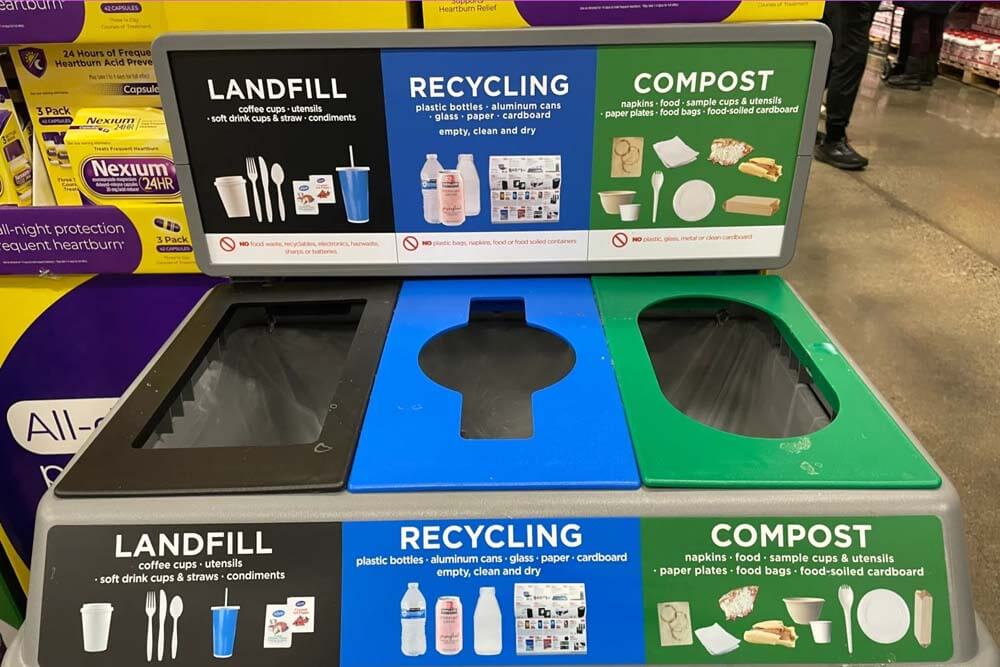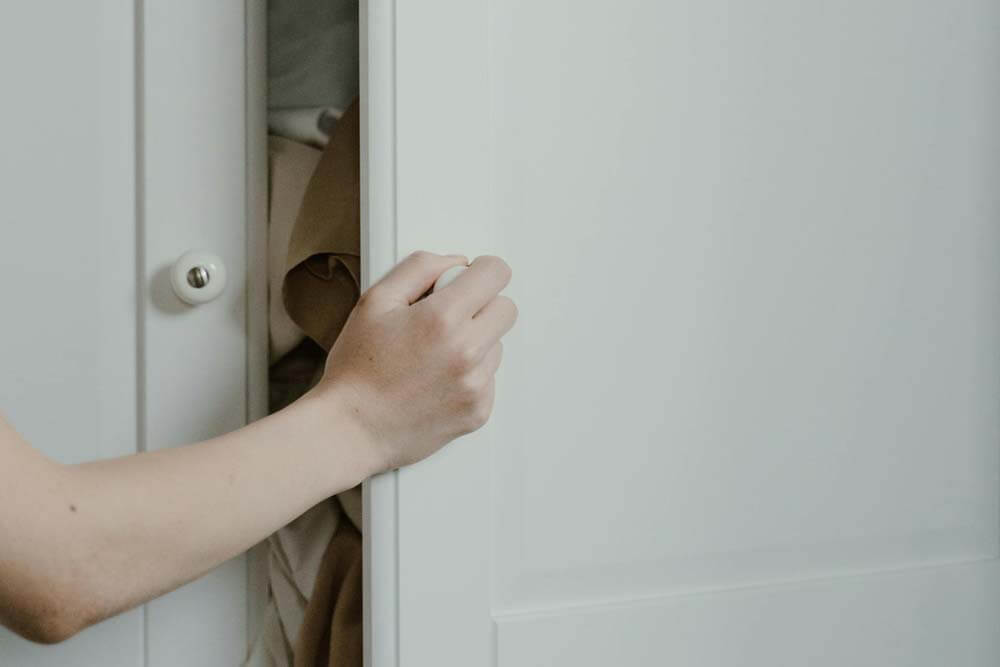If you’ve decided to retire your trusty sex toy, you might be wondering what to do next. Tossing it in the trash feels wasteful, but how can you dispose of it responsibly and discreetly? Not all sex toys are created equal, so knowing the material and type is key to choosing the best method.
Sex toys can be made from various materials like silicone, glass, metal, or hard plastic, and each requires a different approach to disposal. For example, toys made from non-recyclable materials, like certain soft plastics, may need to go to a landfill. However, toys with recyclable parts, such as battery-operated vibrators, can often be broken down and recycled.
- Problem 1: Not for Family Dustbin
- Problem 2: It's Embarrassing
- Problem 3: Some Not for Recycle Bin
- Condition 1: Rubber/Jelly/TPE Toys (Non-Moving) – Landfill
- Condition 2: Plastic (Except Black) – Treat as Normal Plastic
- Condition 3: Glass – Landfill (Don't Treat It as Normal Glass)
- Condition 4: Metal – Treat as Normal Metal
- Condition 5: Silicone – Recycle
- Condition 6: Electronic Toy – Chop and Recycle Separately
- Condition 7: Fabric – Normal Fabric Recycling
- What If I Don't Want to Bother?
- Do Sextoyforbeginners Accept Recycling Service?
- How to Add Discretion?
- Things to Consider
- To Wrap Up
In this blog, we’ll guide you step by step through the most eco-friendly and discreet ways to dispose of your used sex toys responsibly. Stay tuned!
Problem 1: Not for Family Dustbin
Living with your parents or sharing a household can make disposing of a sex toy a bit tricky. Tossing it into the family dustbin isn’t exactly an option if you want to keep things private. Imagine the awkwardness if someone finds it while taking out the trash—definitely not a situation you want to deal with!
Problem 2: It’s Embarrassing
Let’s face it—disposing of a sex toy in public can feel awkward. Whether it’s at your local trash bin, recycling center, or anywhere someone might catch a glimpse, the fear of being judged or recognized can make the situation nerve-wracking.
The good news? There are ways to avoid the embarrassment. Start by ensuring the toy is thoroughly cleaned and wrapped in something completely opaque, like a black garbage bag or an unmarked cardboard box. This hides the contents and avoids any uncomfortable questions if someone happens to notice.
Problem 3: Some Not for Recycle Bin
When it comes to sex toys with electronic components, like vibrators or rechargeable devices, simply tossing them into the recycling bin isn’t a safe option. Electronic parts, including motors, batteries, and wiring, can be harmful to recycling workers and the environment if not disposed of properly. These materials often contain hazardous substances, such as lithium or mercury, which can leak into the environment or cause accidents during the recycling process.
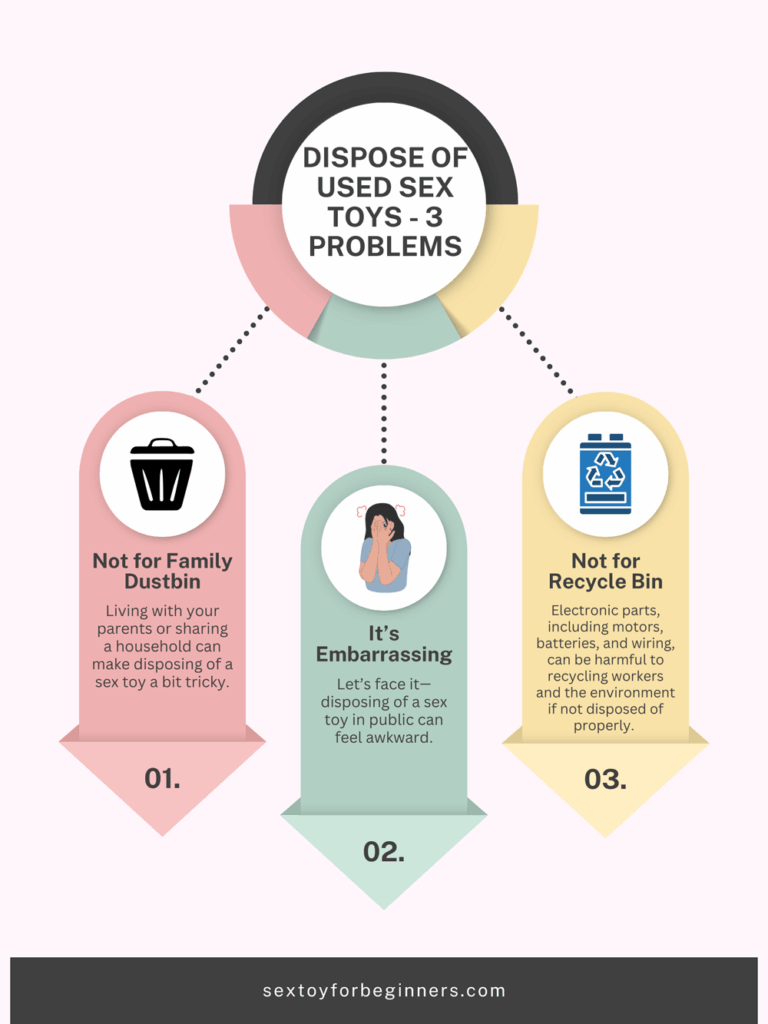
Condition 1: Rubber/Jelly/TPE Toys (Non-Moving) – Landfill
Rubber, jelly, and TPE (Thermoplastic Elastomer) are common materials used in sex toys, especially for non-moving or simple designs. While these materials are soft and flexible, they unfortunately don’t fare well in terms of recycling. Due to their composition and mixed polymers, they are not accepted in regular recycling streams.
As a result, when it comes to disposing of these types of toys, landfill is often the only viable option. However, there are still steps you can take to make the process as discreet and eco-friendly as possible.
First, make sure the toy is thoroughly cleaned and sanitized before disposal. Once it’s clean, wrap it in an opaque bag or a layer of newspaper to avoid drawing attention when you throw it out. This will keep your privacy intact and prevent unwanted embarrassment if someone else handles the trash.
To minimize your impact on the environment, consider reducing your consumption of these types of toys by opting for higher-quality, longer-lasting options like silicone, glass, or metal in the future. These materials are more durable, and many can be recycled, making them a better choice for both your privacy and the planet.
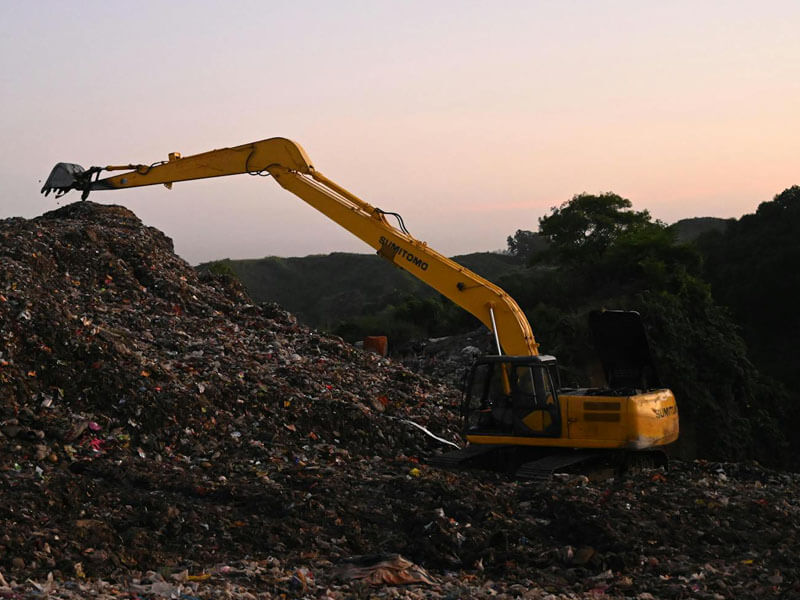
Condition 2: Plastic (Except Black) – Treat as Normal Plastic
Plastic sex toys, especially those that aren’t black in color, are typically made from materials like hard plastic or ABS plastic. These types of plastics are recyclable, so you don’t need to toss them in the landfill—provided you dispose of them properly.
To dispose of a plastic sex toy, start by removing any electronic parts, batteries, or motors, as these should be handled separately (usually at an e-waste facility). Once you’ve separated these components, you can place the plastic toy in your regular recycling bin if your local recycling center accepts hard plastics. Make sure the toy is cleaned before recycling, as food or bodily fluids could contaminate the recycling process.
It’s important to note that some plastic toys are made of mixed materials or may have coatings that complicate recycling. In such cases, you can check with your local recycling program for any special instructions, or even take the toy to a facility that accepts small electronics or specialty plastics.
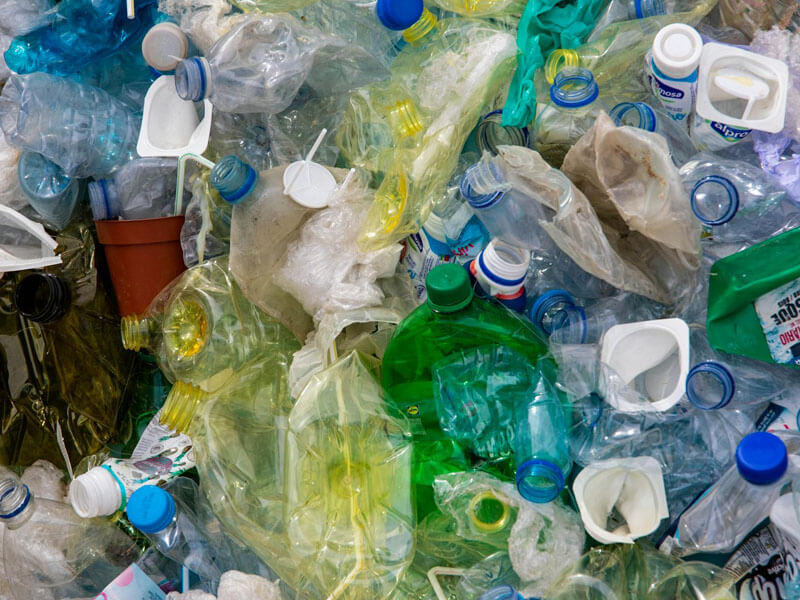
Condition 3: Glass – Landfill (Don’t Treat It as Normal Glass)
Glass sex toys, while sleek and durable, are often made from high borosilicate glass. This type of glass is different from the regular glass used in bottles or jars, as it’s designed to withstand high temperatures and thermal shock. Unfortunately, because of its specialized composition, high borosilicate glass is not accepted by most recycling centers, and therefore cannot be recycled like regular glass.
So, what’s the best way to dispose of a glass sex toy? Unfortunately, the reality is that these toys generally have to go to the landfill. However, there are ways to make the process more discreet and environmentally conscious. Before throwing it out, ensure that the toy is clean to avoid any hygiene concerns. You can then wrap it in a thick layer of newspaper, bubble wrap, or an opaque plastic bag to keep it from drawing attention when placed in the trash.
While it’s disappointing that high borosilicate glass can’t be recycled, you can minimize your impact by considering alternative materials like silicone or metal for future purchases, which are far more recyclable.

Condition 4: Metal – Treat as Normal Metal
Metal sex toys, whether made from stainless steel, aluminum, or other metal alloys, are much easier to dispose of responsibly compared to other materials. Metals are widely recyclable, so you can treat these toys just like any other metal item when it comes to disposal.
To properly dispose of a metal sex toy, start by removing any electronic components, batteries, or other non-metal parts. These should be disposed of separately, either in an electronics recycling center or according to your local waste management guidelines. The metal parts of your toy, however, can be taken to your local recycling facility or a dedicated metal recycling center. Many cities offer metal collection points where scrap metal and other recyclables are accepted.
By recycling metal sex toys, you’re not only disposing of them responsibly, but you’re also contributing to a more sustainable future. Metal is one of the most recyclable materials, and reusing it helps reduce waste and the need for new raw materials.
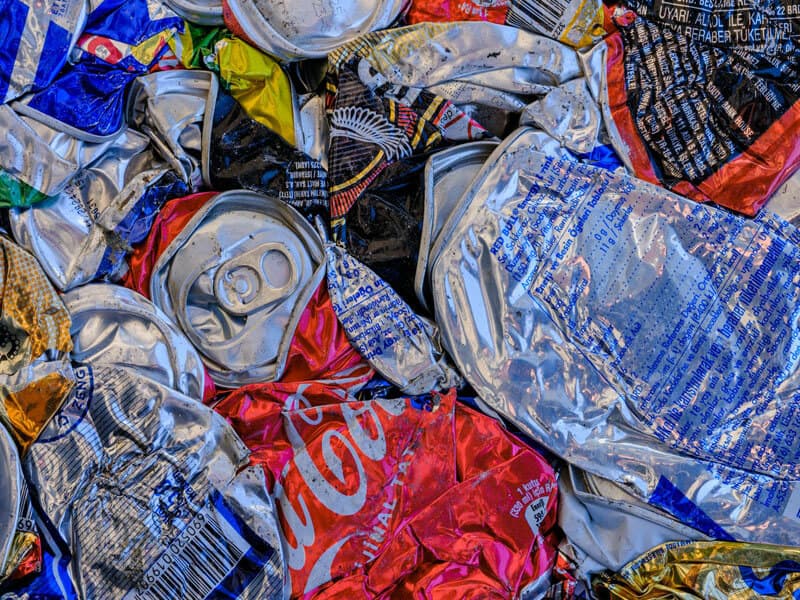
Condition 5: Silicone – Recycle
Silicone is a popular material for high-quality sex toys due to its durability, flexibility, and body-safe properties. It’s also a highly useful and eco-friendly material in many other industries. But when it comes to disposal, things can get tricky—while silicone is technically recyclable, not all recycling centers accept it.
In areas where silicone recycling is available, it can be treated like other recyclable plastics or rubber materials. However, due to its specialized properties, it may need to be sent to a specific facility that handles silicone products, rather than just placed in your regular curbside recycling bin.
Before recycling a silicone toy, make sure it’s clean and free of any fluids, as contamination can hinder the recycling process. Also, check with your local recycling center or waste management program to see if they accept silicone. If they don’t, you may need to explore alternative options, like sending it to a specialized recycling service, or looking for a drop-off location that accepts such materials.
If silicone recycling isn’t available in your area, unfortunately, the toy may need to go to the landfill. To minimize the environmental impact, consider opting for silicone products in the future that have a longer lifespan and can be reused or repurposed in other ways.
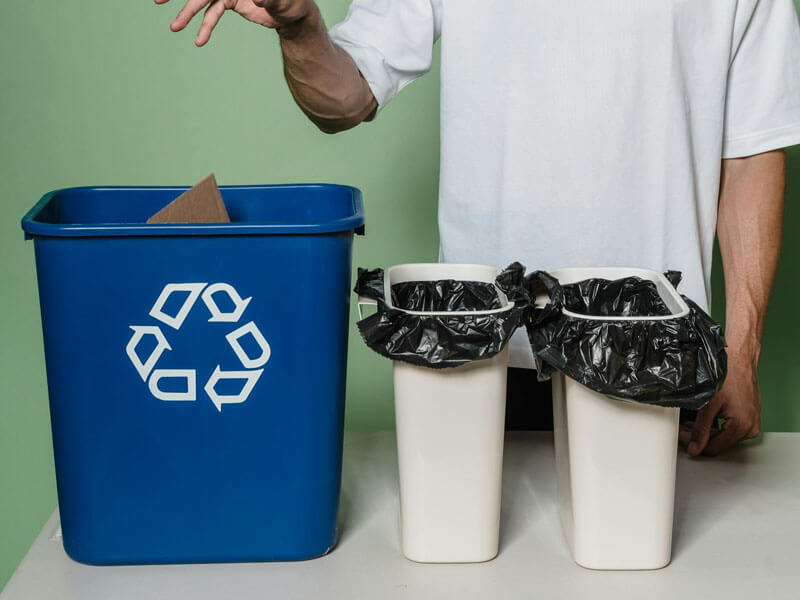
Condition 6: Electronic Toy – Chop and Recycle Separately
When it comes to electronic sex toys, like vibrators, proper disposal is essential for both safety and environmental reasons. These toys often contain small motors, wiring, batteries, and other electronic components that can be harmful if disposed of improperly. Throwing the toy away as a whole is not a good idea, as the electrical parts may pose a risk to recycling workers and can even contaminate the recycling process.
The best way to dispose of electronic toys is to break them down into their separate parts. Start by removing the battery (if it’s removable) and any electronics like wires or motors. Batteries should be recycled at a dedicated e-waste facility, as they contain hazardous materials. Many cities have e-waste collection points or special drop-off locations where batteries and small electronics can be disposed of safely.

After removing the electrical components, you can recycle the plastic casing or body of the toy, provided it’s made of recyclable plastic. Make sure to check with your local recycling center to confirm that the type of plastic is accepted. If it’s a more complex plastic that’s not easily recyclable, it may need to go to the landfill, but it’s worth checking first.
Dividing your electronic toy into its parts not only helps prevent harm to recycling workers but also ensures that both the electronics and plastic are disposed of in the most environmentally responsible way possible.
Condition 7: Fabric – Normal Fabric Recycling
Fabric-based sex toys or accessories (such as those made from soft materials like velvet, cotton, or other textiles) can generally be recycled with normal fabric recycling. However, there are a few steps to take to ensure they are properly disposed of in an environmentally friendly way.
First, check the material of the fabric. If it’s made from a natural fiber (like cotton or wool), it’s usually easier to recycle through textile recycling programs. Synthetic fabrics, such as polyester or nylon, may be more challenging to recycle, but some programs still accept them.
Before recycling, make sure the fabric is clean. Any oils, lotions, or bodily fluids can contaminate the recycling process, so it’s best to wash and sanitize the item before disposal. If the fabric is part of a larger item (like a padded toy or accessory), be sure to remove any non-fabric components (such as padding or plastic) and dispose of those separately.
If your local recycling center doesn’t accept fabric or textiles, look for a donation center that takes used textiles, or find a dedicated fabric recycling program in your area. Many cities now have programs that recycle old clothes and fabrics, so it’s worth checking if you can drop off your fabric item at one of these locations.
Recycling fabric helps divert waste from landfills and gives textiles a second life, making it an eco-friendly choice for disposal.
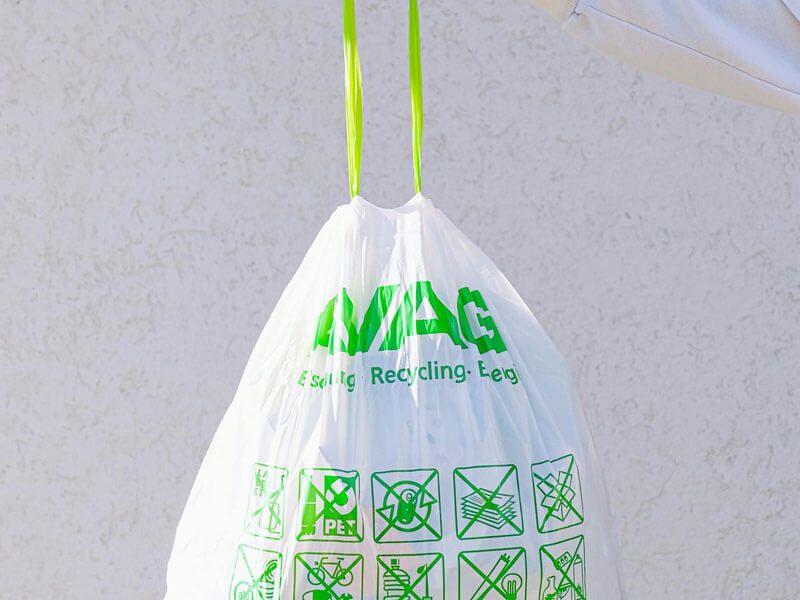
What If I Don’t Want to Bother?
If you’re not interested in the hassle of sorting through parts or dealing with local recycling centers, there are convenient mail-in recycling programs that can handle everything for you!
Companies like ScarletGirl and EdenFantasys offer specialized recycling services for used sex toys, which allow you to send your old toys to them for responsible disposal. This option provides a discreet and stress-free solution for those who don’t want to deal with the logistics of proper disposal.
Do Sextoyforbeginners Accept Recycling Service?
At Sextoyforbeginners, we understand the importance of responsible disposal, but unfortunately, we do not offer a recycling service at this time. Shipping used toys back to China for proper recycling would be both expensive and impractical for our customers.
How to Add Discretion?
Discretion is key when disposing of used sex toys, especially if you’re worried about privacy or don’t want to raise any awkward questions. Here are a few simple ways to ensure your disposal is as discreet as possible:
1. Use Cover Bags
The easiest way to maintain privacy is by wrapping your toy in a cover bag before disposing of it. Use opaque bags (like black garbage bags or unmarked paper bags) that will conceal the toy completely. You can also double-wrap it for extra security. This will keep the toy out of sight, even if someone else handles your trash or recycling.
2. Chop the Toy into Pieces
If you’re particularly concerned about someone recognizing your toy, you can chop it into smaller pieces. By breaking it down, you can ensure that individual parts are unrecognizable, especially if the toy contains electronic components or unique shapes. For example, separate the motor from the plastic body and chop the pieces into small, inconspicuous parts that blend in with regular waste.
3. Go to Public Dustbins
If you have access to public waste bins, consider using them for disposal. Public trash bins are less likely to be scrutinized, offering a simple, discreet option for tossing your toy. Just make sure the toy is wrapped securely and the bag is sturdy enough to prevent any accidental exposure.
4. Take Advantage of Late-Night Disposal
If you’re disposing of your toy at home, consider doing so during late hours or early mornings when fewer people are likely to see you. The less attention your disposal process draws, the better.

By taking these extra steps, you can ensure that your disposal is both discreet and environmentally conscious, allowing you to say goodbye to your toy without any unwanted attention.
Things to Consider
Recycling a sex toy is a responsible choice, but there are a few important steps to keep in mind to ensure the process is safe, effective, and discreet. Here’s what you should consider before sending your used toy to the recycling bin or facility:
1. Clean the Toy Thoroughly
Before recycling, it’s essential to clean your sex toy properly. This ensures that there are no lingering bodily fluids, lubricants, or other contaminants that could interfere with the recycling process. Clean the toy with warm water and mild soap, or use a specialized toy cleaner. For toys with batteries or electronic parts, be sure to dry them completely before disposal. Clean toys are not only safer to handle but also less likely to contaminate other materials during recycling.
2. Ensure Safety
Safety is crucial when handling used sex toys, especially those with electrical components, such as vibrators or toys with motors. Always remove batteries or electrical parts before recycling. These components should be taken to an e-waste recycling facility, as they often contain hazardous materials like lithium or mercury, which can pose a risk if not properly disposed of. If you’re unsure how to safely remove the electrical components, it’s best to contact a local recycling center for guidance.
3. Judge the Material Correctly
Different materials require different recycling methods. Before tossing your toy into a recycling bin, check what it’s made of. Common materials like silicone, metal, and plastic can often be recycled, but others, like rubber or jelly toys, might need to be sent to a landfill. If your toy contains mixed materials (such as silicone with embedded electronics), you may need to separate them before recycling. Always verify the type of material and consult your local recycling program to understand how to handle it properly.
4. Try to Reuse
Before recycling, consider whether your toy can be reused or repurposed. If it’s still in good condition, you might want to donate it (if it’s safe to do so) or keep it as a backup. Some toys, especially high-quality silicone or metal ones, can last a long time with proper care, reducing the need for frequent disposal. Alternatively, if your toy has small, non-electronic parts that can be recycled individually (like the silicone sleeve or plastic body), separating these parts for recycling can help.
5. Consider Privacy
Always think about discretion when recycling sex toys. Wrap the toy in a non-transparent bag or box before taking it to the recycling bin to avoid any embarrassment. If you’re mailing it to a recycling service, ensure that it’s securely packaged, so it’s completely hidden from view. Taking these extra steps ensures that your privacy is maintained throughout the disposal process.
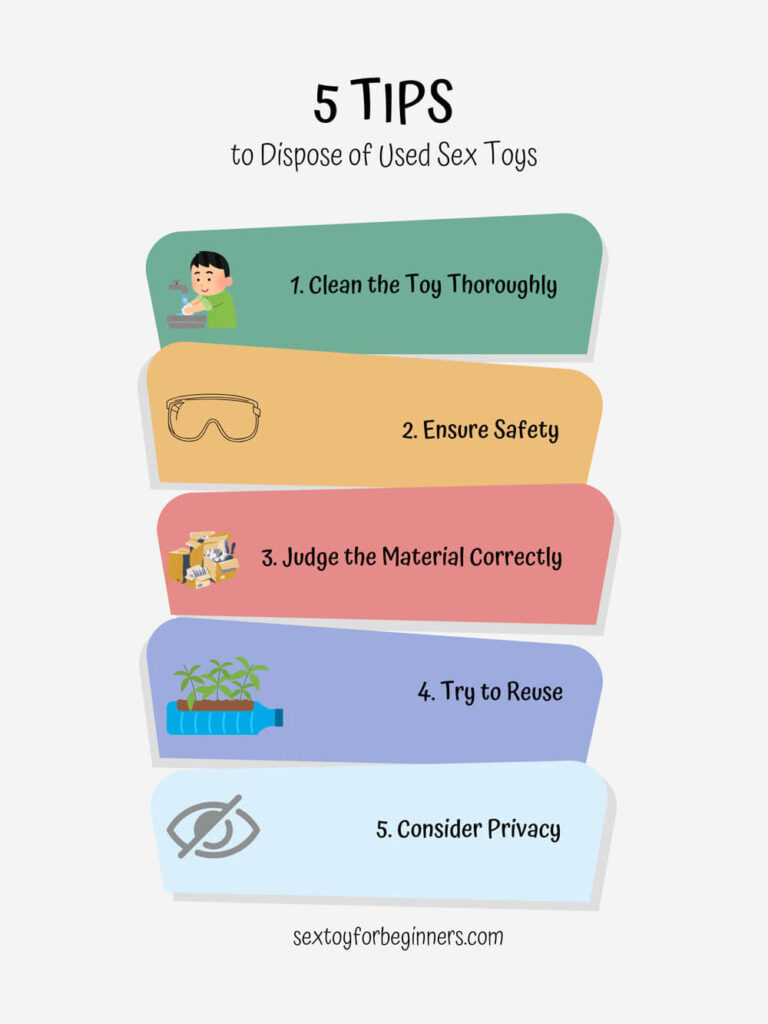
By following these steps, you can recycle your sex toys responsibly while ensuring safety, discretion, and environmental mindfulness. Reusing, cleaning, and sorting materials correctly all contribute to a more sustainable approach to toy disposal.
To Wrap Up
Disposing of and recycling used sex toys may seem like a tricky task, but with the right knowledge and a bit of effort, you can do it responsibly and discreetly. Whether you’re dealing with plastic, silicone, metal, or electronic toys, understanding the material and following the proper disposal methods ensures that you contribute to a cleaner, greener planet while maintaining your privacy.
Start by cleaning your toy thoroughly and breaking it down into recyclable parts—remove any batteries or electronics, as these should be recycled separately. Use cover bags or chop the toy into pieces if you’re concerned about discretion, and always check your local recycling options to ensure the best disposal method.
By following these simple guidelines, you can enjoy your toys responsibly, recycle properly, and help reduce waste—while keeping everything low-key and eco-friendly!
